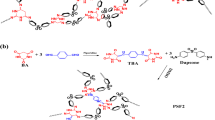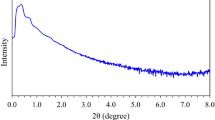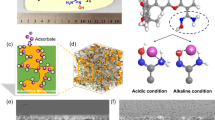Abstract
The idea of developing a system that enables modulation of the amount of Pd(II) ions bonded to a substrate upon exposure to external stimuli could open interesting prospects for application in various research fields such as sensors, catalysis, gas storage, and separation. In this context, in the present work, a photoresponsive compound was used as a functional monomer in the preparation, for the first time, of a photoresponsive ion-imprinted polymer (PIIP) for metal ion uptake. The Pd(II) template was used as a metal ion model, and the binding behavior of PIIP was evaluated under different experimental conditions. The adopted precipitation polymerization technique allowed us to obtain dispersed submicroparticles, as confirmed by the dynamic light scattering and Langmuir isotherm results. The photoisomerization capability of PIIP, with conformational changes of the polymer, was demonstrated, and an improved binding capacity for Pd(II) was observed after UV exposure of the polymer, with a maximum binding capacity approaching 22 mg g−1. Moreover, from the kinetic studies, the equilibrium binding capacity was reached within almost 3 h either in the dark or under UV irradiation. Finally, the reusability of the polymer over three cycles was demonstrated, and the ion selectivity of Pd(II)-PIIP was confirmed when other metal ions such as Ni(II) and Pb(II) were tested.
This is a preview of subscription content, access via your institution
Access options
Subscribe to this journal
Receive 12 print issues and online access
$259.00 per year
only $21.58 per issue
Buy this article
- Purchase on Springer Link
- Instant access to full article PDF
Prices may be subject to local taxes which are calculated during checkout










Similar content being viewed by others
References
Vasapollo G, Del Sole R, Mergola L, Lazzoi MR, Scardino A, Scorrano S, et al. Molecularly imprinted polymers: present and future prospective. Int J Mol Sci. 2011;12:5908–45.
Chen L, Wang X, Lu W, Wu X, Li J. Molecular imprinting: perspectives and applications. Chem Soc Rev. 2016;5:2137–211.
Wei YB, Tang Q, Gong CB, Lam MHW. Review of the recent progress in photoresponsive molecularly imprinted polymers containing azobenzene chromophores. Anal Chim Acta. 2015;900:10–20.
Wang L, Li Q. Photochromism into nanosystems: towards lighting up the future nanoworld. Chem Soc Rev. 2018;47:1044–97.
Lee S, Oh S, Lee J, Malpani Y, Jung Y, Kang B, et al. Stimulus-responsive azobenzene supramolecules: fibers, gels, and hollow spheres. Langmuir 2013;29:5869–77.
Yao X, Li T, Wang J, Ma X, Tian H. Recent progress in photoswitchable supramolecular self-assembling systems. Adv Optical Mat. 2016;4:1322–49.
Bandara HMD, Burdette SC. Photoisomerization in different classes of azobenzene. Chem Soc Rev. 2012;41:1809–25.
Seki T. New strategies and implications for the photoalignment of liquid crystalline polymers. Polym J 2014;6:751–68.
Gong C, Wong KL, Lam MHW. Photoresponsive molecularly imprinted hydrogels for the photoregulated release and uptake of pharmaceuticals in the aqueous media. Chem Mater 2008;20:1353–8.
Ma Y, Zhang H, Li H, He S, Zhang H. Efficient one-pot synthesis of water-compatible and photoresponsive molecularly imprinted polymer nanoparticles by facile RAFT precipitation polymerization. J Polym Sci Pol Chem. 2014;52:1941–52.
Li ZY, Quan HJ, Gong CB, Yang YZ, Tang Q, Wei YB, et al. Photocontrolled solid-phase extraction of guanine from complex samples using a novel photoresponsive molecularly imprinted polymer. Food Chem 2015;172:56–62.
Liu Y, Zhong G, Liu Z, Meng M, Liu F, Ni L. Facile synthesis of novel photoresponsive mesoporous molecularly imprinted polymers for photo-regulated selective separation of bisphenol A. Chem Eng J. 2016;296:437–46.
Gong CB, Wei YB, Liu LT, Zheng AX, Yang YH, Chow CF, et al. Photoresponsive hollow molecularly imprinted polymer for trace triamterene in biological samples. Mater Sci Eng C 2017;76:568–78.
Fan H, Wang J, Meng Q, Jin Z. Monodisperse hollow-shell structured molecularly imprinted polymers for photocontrolled extraction α-cyclodextrin from complex samples. Food Chem 2019;281:1–7.
Del Sole R, De Luca A, Catalano M, Mele G, Vasapollo G. Noncovalent imprinted microspheres: preparation, evaluation and selectivity of DBU template. J Appl Polym Sci. 2007;105:2190–7.
Del Sole R, Scardino A, Lazzoi MR, Vasapollo G. Molecularly imprinted polymer for solid phase extraction of nicotinamide in pork liver samples. J Appl Polym Sci. 2011;120:1634–41.
Scorrano S, Mergola L, Del Sole R, Vasapollo G. Synthesis of molecularly imprinted polymers for amino acid derivates by using different functional monomers. Int J Mol Sci. 2011;12:1735–43.
Mergola L, Scorrano S, Del Sole R, Lazzoi MR, Vasapollo G. Developments in the synthesis of a water compatible molecularly imprinted polymer as artificial receptor for detection of 3-nitro-l-tyrosine in neurological diseases. Biosens Bioelectron 2013;40:336–41.
Scorrano S, Mergola L, Di Bello MP, Lazzoi MR, Vasapollo G, Del Sole R. Molecularly imprinted composite membranes for selective detection of 2-deoxyadenosine in urine samples. Int J Mol Sci. 2015;16:13746–59.
Mergola L, Scorrano S, Bloise E, Di Bello MP, Catalano M, Vasapollo G, et al. Novel polymeric sorbents based on imprinted Hg(II)-diphenylcarbazone complexes for mercury removal from drinking water. Polym J 2016;48:73–79.
Di Bello MP, Mergola L, Scorrano S, Del Sole R. Towards a new strategy of a chitosan-based molecularly imprinted membrane for removal of 4-nitrophenol in real water samples. Polym Int 2017;66:1055–63.
Di Bello MP, Lazzoi MR, Mele G, Scorrano S, Mergola L, Del Sole R. A new ion-imprinted chitosan-based membrane with an azo-derivative ligand for the efficient removal of Pd(II). Materials 2017;10:1133.
Mergola L, Orabona C, Albini E, Vasapollo G, Scorrano S, Del Sole R. Urinary L-kynurenine quantification and selective extraction through a molecularly imprinted solid phase extraction device. J Sep Sci. 2018;41:3204–12.
Atayat A, Mergola L, Mzoughi N, Del Sole R. Response surface methodology approach for the preparation of a molecularly imprinted polymer for solid-phase extraction of fenoxycarb pesticide in mussels. J Sep Sci. 2019;42:3023–32.
Jiang Y, Kim D. Synthesis and selective adsorption behavior of Pd(II)-imprinted porous polymer particles. Chem Eng J. 2013;232:503–9.
Monier M, Abdel-Latif DA, El-Reash YGA. Ion-imprinted modified chitosan resin for selective removal of Pd(II) ions. J Colloid Interface Sci. 2016;469:344–54.
Lai W, Zhang K, Shao P, Yang L, Ding L, Pavlostathis SG, et al. Optimization of adsorption configuration by DFT calculation for design of adsorbent: a case study of palladium ion-imprinted polymers. J Hazard Mater. 2019;379:120791.
Zhang S, Ding Y, Liu B, Chang CH. Supply and demand of some critical metals and present status of their recycling in WEEE. Waste Manag 2017;65:113–27.
Bojdi MK, Behbahani M, Sahragard A, Amin BG, Fakhari A, Bagheri A. A palladium imprinted polymer for highly selective and sensitive electrochemical determination of ultra-trace of palladium ion. Electrochim Acta 2014;149:108–16.
Liu Y, Huang Z, Li J, Chen J. Solvent extraction of palladium(II) from alkaline cyanide solution by the dodecyl dimethyl-2-phenoxyethyl ammonium bromide. J Chil Chem Soc. 2016;61:2864–9.
Xi X, Song S, Nie Z, Ma L. Preparation and electrochemical behavior of palladium in ionic liquid. Int J Electrochem Sci. 2015;10:9179–91.
Alzahrani S, Mohammad AW. Challenges and trends in membrane technology implementation for produced water treatment: a review. J Water Process Eng. 2014;4:107–33.
Yin QH, Zhu DM, Yang DZ, Hu QF, Yang YL. Rapid detection of trace palladium in active pharmaceutical ingredients by magnetic solid phase extraction and flame atomic absorption spectroscopy. J Appl Spectrosc. 2018;84:1–5.
Mladenova E, Karadjova I, Tsalev DL. Solid-phase extraction in the determination of gold, palladium, and platinum. J Sep Sci. 2012;35:1249–65.
Sarioglan S. Recovery of palladium from spent activated carbon-supported palladium catalysts. Platin Met Rev. 2013;57:289–96.
Wang H, Bao C, Li F, Kong X, Xu J. Preparation and application of 4-amino-40-nitro azobenzene modified chitosan as a selective adsorbent for the determination of Au(III) and Pd(II). Microchim Acta 2010;168:99–105.
Ni H, Kawaguchi H. Mechanism of preparing monodispersed poly (acrylamide/methacrylic acid) microspheres in ethanol. I J Polym Sci Part A. 2004;42:2823–34.
Cacho C, Turiel E, Martin-Esteban A, Pérez-Conde C, Cámara C. Characterisation and quality assessment of binding sites on a propazine-imprinted polymer prepared by precipitation polymerisation. J Chromatogr B. 2004;802:347–53.
Liu HD, Zheng AX, Gong CB, Ma XB, Lam MHW, Chow CF, et al. A photoswitchable organocatalyst based on a catalyst-imprinted polymer containing azobenzene. RSC Adv 2015;5:62539–42.
Nguyena TH, Sonu CH, Lee MS. Separation of platinum(IV) and palladium(II) from concentrated hydrochloric acid solutions by mixtures of amines with neutral extractants. J Ind Eng Chem. 2015;32:238–45.
Akdi K, Vilaplana RA, Kamah S, Gonzalez-Vılchez F. Effects of Tris and Hepes buffers on the interaction of palladium-diaminopropane complexes with DNA. J Inorg Biochem. 2005;99:1360–8.
Yang YZ, Tang Q, Gong CB, Ma XB, Peng JD, Lam M. Ultrasensitive detection of bisphenol A in aqueous media using photoresponsive surface molecular imprinting polymer microspheres. N. J Chem. 2014;38:1780–8.
Author information
Authors and Affiliations
Corresponding author
Ethics declarations
Conflict of interest
The authors declare that they have no conflict of interest.
Additional information
Publisher’s note Springer Nature remains neutral with regard to jurisdictional claims in published maps and institutional affiliations.
Rights and permissions
About this article
Cite this article
Mergola, L., Stomeo, T. & Del Sole, R. Synthesis of photoswitchable submicroparticles and their evaluation as ion-imprinted polymers for Pd(II) uptake. Polym J 52, 743–754 (2020). https://doi.org/10.1038/s41428-020-0319-8
Received:
Revised:
Accepted:
Published:
Issue Date:
DOI: https://doi.org/10.1038/s41428-020-0319-8
This article is cited by
-
Fabrication of Cobalt tagged smart ion-imprinted polymeric material applied for the elimination of Co2+ ions from real environmental samples
Polymer Bulletin (2022)
-
Fast and efficient adsorption of palladium from aqueous solution by magnetic metal–organic framework nanocomposite modified with poly(propylene imine) dendrimer
Environmental Science and Pollution Research (2021)



